|
 
 |
| ORIGINAL ARTICLE |
|
| Year : 2014 | Volume
: 2
| Issue : 2 | Page : 49-53 |
|
Finger and palmar dermatoglyphic study among the Yorubas in Jos, Nigeria
Adebanji M Akingbade1, Linus C Saalu2, Gabriel G Akunna3, Linus E Anderson1, FS Olusolade1
1 Department of Anatomy, Afe Babalola University, Ado Ekiti, Ekiti State, Nigeria
2 Department of Anatomy, Benue State University, Makurdi, Benue State, Nigeria
3 Department of Anatomy, Federal University, Ndufu Alike Ikwo, Ebonyi State, Nigeria
| Date of Web Publication | 23-Mar-2015 |
Correspondence Address:
Gabriel G Akunna
Department of Anatomy, Federal University, Ndufu Alike Ikwo, Ebonyi State
Nigeria
 Source of Support: None, Conflict of Interest: None  | Check |
DOI: 10.4103/2315-7992.153815

Introduction: Palm prints and toe prints are epidermal ridges that form early in fetal life and are unique to each individual. This means that they can be used for personal identification in criminal investigations. They are useful in diagnosis since recurring abnormal patterns are often seen in a variety of genetic syndromes. Materials and Methods: In this study, the palm prints of 170 young Yoruba students consisting of 75 males aged between 8 years and 19 years, and 95 females aged between 7 years and 18 years were used for the measurement of the ADT angle, AB ridge count (ABRC), and total ridge count (TRC) after informed consent. The patterns were obtained using the ink method and these were taken on white duplicating paper. The ridges were counted using hand lens and needle while the ADT angles were measured with a protractor. Results: The finding of higher values of ABRC (70.77), TRC (123.07), and the average ADT angle (40.42) in female Yorubas compared with males were 68.31, 122.39, and 39.29, respectively, and is in conflict with the results of most of the studies documented in other scientific journals. Conclusion: Our study without a doubt confirms that anthropometric dissimilarities subsist based on sex. The data submitted herein can provide useful information to the forensic investigators and scientist in solving cases especially when it involves individuals from the Yoruba ethnic group. Keywords: Dermatoglyphics, fingerprints, forensic science, palm prints, Yorubas
How to cite this article:
Akingbade AM, Saalu LC, Akunna GG, Anderson LE, Olusolade F S. Finger and palmar dermatoglyphic study among the Yorubas in Jos, Nigeria. Ann Bioanthropol 2014;2:49-53 |
How to cite this URL:
Akingbade AM, Saalu LC, Akunna GG, Anderson LE, Olusolade F S. Finger and palmar dermatoglyphic study among the Yorubas in Jos, Nigeria. Ann Bioanthropol [serial online] 2014 [cited 2018 Sep 6];2:49-53. Available from: http://www.bioanthrojournal.org/text.asp?2014/2/2/49/153815 |
| Introduction | |  |
Dermatoglyphics was derived from the Greek word "dermis," meaning skin and "glyph," meaning curving. Dermatoglyphics is the science of configuration of the epidermal ridges of the volar surfaces of the fingers, toes, palms, and soles. [1] Dermatoglyphic traits serve as useful tools in the diagnosis of congenital malformations. [2] They are valuable as somatic markers of genetic and environmental influences that may destabilize developmental processes prenatally. [1],[3]
Most dermatoglyphic traits develop in utero during weeks 17 through 24 and remain unchanged during the individual's lifetime. [4] Therefore, analyses of dermatoglyphic traits can provide information on intrauterine disturbances and possibly even genetic abnormalities. [4],[5] The most commonly analyzed dermatoglyphic traits include descriptions of the finger and the hypothenar patterns; measurements of ridge counts between triradii (points formed by the convergence of the ridges); measurement of the ADT angle, the angle that exists between the a, d, and t triradii on the palm [Figure 1] as well as the ABRC (the number of finger print lines between the triradius point a and the triradius point b) [Figure 2]. Although the ADT angle has been widely used in dermatoglyphic studies, several researchers have questioned its utility, specifically whether or not it can be measured reliably. [1],[6] Dermatoglyphic parameters like AB ridge count (ABRC), total ridge count (TRC), and ADT angle can help throw light on the important area of biological mathematics and help us understand the mathematics of anatomy and life as it relates to dermatoglyphics.
These parameters may form good tools for predicting the susceptibility of individuals to a variety of genetic diseases.
This study examines the pattern of asymmetry of dermal ridges of the Yorubas. It determines the palmar variables of ADT angle, ABRC, and total finger ridge count (TFRC) of dermal ridges among the Yorubas.
| Materials and methods | |  |
Materials
Decan duplicating ink, Vitafoam pad, wooden slab, duplicating paper, hand lens, protractor, pencil, water, and soap
Study area
This study was conducted in Jos, the capital of Plateau State. Plateau State is a miniature Nigeria because within it are found all the tribes of Nigeria. It is a state in the northern part of the country that harbors a large population of Yorubas who come from different parts of Yorùbáland to trade because of the serene nature of the state. Plateau State is located in the north central part of the country and lies between latitude 70° N and 110° N and longitude 70° E and 250° E. The landscape is almost treeless. It shares boundaries with other states like Nassarawa, Bauchi, Kaduna, and Taraba. Because of the large population of Yorubas in Plateau State in general and Jos in particular, any study conducted here can be a true reflection of what is generally obtainable in the country.
Subjects
The human subjects (volunteers) were from a cross section of some secondary schools in Jos (St. Murumba College, Baptist High School, and Salama private school), and some medical students for the simple reason that they were more readily accessible for the study.
Informed consent was obtained from the students after they were assured of the safety of the research. They were free to express their opinions and ideas. They were assured confidentiality, stating that their personal details or their responses will not be disclosed or used in any other way except for the purpose of the survey. They also had the choice of not participating in the study.
Pretest questions were asked to document the age, sex, father's tribe, and mother's tribe of the volunteers.
Methodology
The palm prints of 170 young Yoruba students consisting of 75 males aged between 8 years and 19 years, and 95 females aged between 7 years and 18 years were examined for the measurement of ADT angle, ABRC, and TRC after a formal permission was obtained from the school authorities.
The subjects were asked to clean their hands with soap and water. The requisite amount of ink was spread uniformly on the palms and fingers using Vitafoam pads. The palm was examined for the uniformity of the ink, and if found otherwise, ink was applied to the hollow of the palm. The left hand of the subject was then placed on the sheet of paper (kept on the table) from the proximal to the distal end. The palm was gently pressed between intermetacarpal grooves at the root of the fingers and on the dorsal part corresponding to the thenar and the hypothenar regions.
The palm was then lifted from the paper in reverse order, from the distal to the proximal end. The fingers were also printed below the palmar print by the rolled fingerprint method. The same procedure was repeated for the right hand on a separate paper. The printed sheets were coded with name, age, sex, and tribe of the subjects.
The prints were then subjected to detailed dermatoglyphic analysis with the help of magnifying hand lens and ridge counting was done with the help of a sharp needle. ADT angle was defined using a pencil and the measurements were taken using a protractor. The details were noted on the same paper with a pencil. The following dermatoglyphic parameters were obtained:
Total ridge counting
This was done along the straight lines connecting the core and the triradius. Ridges containing triradial point and point of core were excluded. In case of whorl with two triradii and at least one point of core, two different counts were made, one from each radii. Each count was made along a line drawn between the triradial point and the nearer point of core. The two counts were specified as first radial and second ulnar counts.
Usually the symbols and ridge counts are recorded in order, beginning with the little finger of the left hand continuing to the thumb, while the digits of the right hand are recorded beginning with the thumb and continuing to the little finger. Because the ridge counts are used to express the size, only the largest count is scored in a pattern with more than one possible count. Both simple and tented arches have "0" count.
TRC
TRC represents the sum of ridge counts of all the 10 digits, where only the larger count is used on those digits with more than one ridge count. It expresses the size of the pattern.
AB ridge count
It refers to the number of ridges between triradii "a" and "b".
ADT angle
This is formed by the lines drawn from digital triradius "a" to the axial triradius "t" and from axial triradius "t" to the digital triradius "d." The more distal the position of "t," the larger the "ADT" angle. The "ADT" angle is the most widely used method in interpreting the position of triradius "t."
Through a valuable and rapid measurement, the ADT angle has the disadvantage of altering with age because of the growth of the hand. It also varies a little with the amount of pressure applied in producing a palm print.
Data analysis
The data obtained were subjected to statistical analysis using Microsoft Excel 2007. The descriptive statistics and the student t-test were used to test significant differences between male and female variables.
| Results | |  |
Quantitative analysis of the dermatoglyphic patterns of the palms of the Yoruba population in Jos for ABRC and the ADT angle gave the measurements presented in [Table 1], [Table 2], [Table 3], [Table 4], [Table 5], [Table 6], [Table 7], [Table 8], [Table 9], [Table 10] and [Table 11].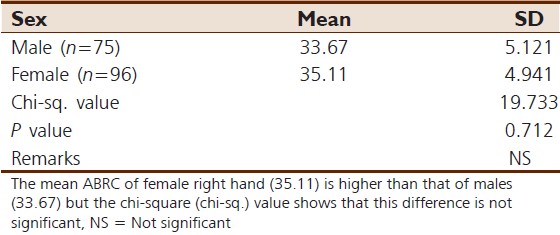 | Table 1: Statistical comparison of ABRC on right hand of male with female
Click here to view |
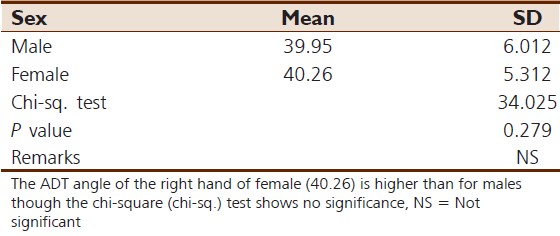 | Table 3: Statistical comparison of ADT angle on right hand of male with female
Click here to view |
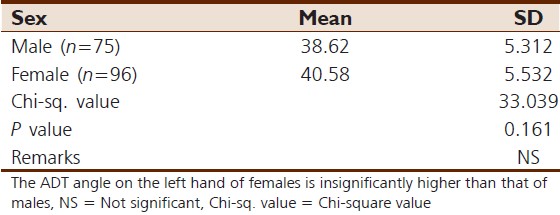 | Table 4: Statistical comparison of ADT angle on the left hand of male with female
Click here to view |
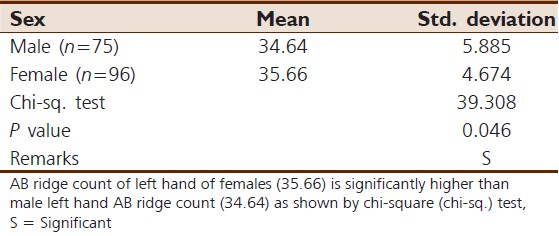 | Table 5: Statistical comparison of ABRC on the left hand of male with female
Click here to view |
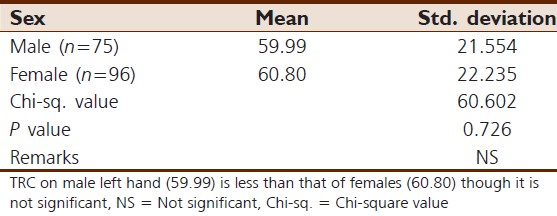 | Table 6: Statistical comparison of TRC on the left hand of male with female
Click here to view |
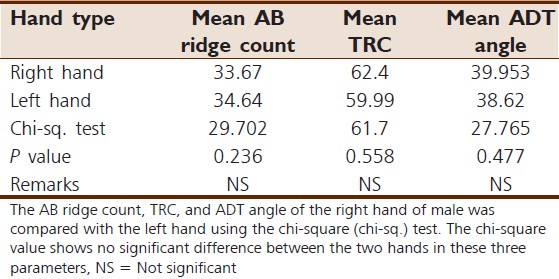 | Table 10: Statistical comparison of ABRC, TRC, and ADT angle of the right hand with the left hand in male
Click here to view |
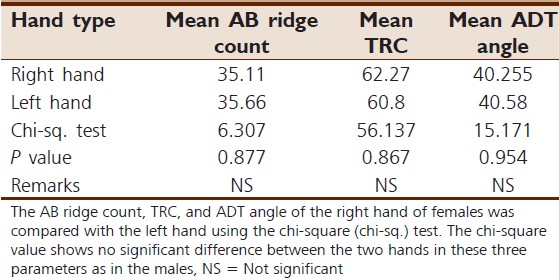 | Table 11: Statistical comparison of ABRC, TRC, and ADT angle of the right hand with the left hand in female
Click here to view |
Also shown are the palm prints of two Yoruba subjects, one female and one male [Figure 1] and [Figure 2].
Right ABRC of male and female hands
Although the difference was not significant, the mean ABRC of the female right hand (35.11) is higher than that of males (33.67) [Table 1].
TRC on the right hand of male and female
As shown in [Table 2], there was no significant difference between the TRC of the right hand of males and females.
Comparison of the ADT angle on the right and the left hand of male with female
Although the ADT angle of the right (40.26) and left (40.58) hand of females was higher than that of the Males (39.95 and 38.62 respectively), it was not significant [Table 3] and [Table 4].
Left ABRC of male and female hands
ABRC of the left hand of females (35.66) was significantly higher than ABRC of the left hand of males (34.64), as shown by the chi-square test [Table 5].
Comparison of TRC on the left hand of male with female
TRC on the left hand of males (59.99) was less than that of females (60.80), as shown in [Table 6].
Comparison of TFRCs of male with female
[Table 7] shows that the TRFC of males was insignificantly lower than that of females.
Comparison of total ABRC of males with females
Females have a higher ridge count than males as shown by the chi-square test, which is not significant.
Comparison of ADT angle of male with female
As shown in [Table 9], there was no significant difference in the male and female mean ADT angle.
Comparison of ABRC, TRC, and ADT angle of the right hand with the left hand in males
The ABRC, TRC, and ADT angle of the right hand were compared with the left hand using the chi-square test. The chi-square value shows no significant difference between the two hands in these three parameters [Table 10].
Comparison of ABRC, TRC, and ADT angle of the right hand with the left hand in females
The ridge count, TRC, and ADT angle of the right hand were compared with the left hand using the chi-square test. The chi-square value shows no significant difference between the two hands in these three parameters as in case of males.
| Discussion | |  |
Dermatoglyphics is of interest in such diverse fields as medicine, anthropology, and criminology.
Differences in the level of sexual dermatoglyphic dimorphism have been detected in various populations. [1],[7],[8] Two individuals with the same TRC can have quite different counts on individual fingers, while another may have a low count on some fingers and a high count on others. [7],[9] This study was carried out on Yoruba students in a cross section of schools in Jos, the capital of Plateau State, Nigeria. For this study the palm prints of 170 young Yoruba students consisting of 75 males aged between 8 years and 19 years, and 95 females aged between 7 years and 18 years were recorded. The prints were then examined for measurements of ATD angle, ABRC, and TRC. The observed values in the current city were first subjected to the test of statistical significance and the findings were then compared with the available literature of previous workers. The result of this study showed that females have a wider ADT angle (40.26) on the right hand than males (39.95). A similar result was found on the left hand. When the result was tested with the chi-square test, it showed that these values were not significant. The ABRC in the female right hand (35.11) was higher than the male count (33.67), though not significant. A similar result was obtained from ABRC of the left hand. Males have a lower TRC (62.22) on the right hand than females (62.27), though it is not a significant difference. A similar result was obtained on the left hand, males (59.99) and females (60.80). Statistical values of the mean ATD angle of males were also compared with that of females and the following results were obtained. The mean value for males (39.29) was less than the value for females (40.42). The chi-square test, however, showed that the difference was not significant. The mean ABRC, TRC, and ATD angle of the right hand were compared with the value for the left hand in males and it was found that the mean ABRC (33.67) of the right hand was less than ABRC (34.64) of the left hand. For the mean TRC, the right hand value (62.4) was higher than that of the left hand value (59.99). For the mean ATD angle, right hand value (39.95) was higher than that of the left hand value (38.62). The mean ABRC in female shows higher value on the left hand (35.66) than the right hand (35.11). The mean TRC of the right hand (62.27) was higher than that of the left hand (60.8). The mean ATD angle of the left hand (40.58) was higher than that of the right hand (40.25). The TFRC, ABRC, and average ATD angle of both hands were computed and the following values were obtained. The mean TRC of both hands of the male was 122.39 while that of the female was higher (123.07). Mean ABRC of both hands in males (68.31) was lower than that of females (70.77). Average value of ATD angle of both male hands (39.29) was lower than that of female hands (40.42). The finding of higher values of mean ABRC, mean TRC, and average ATD angle in female Yorubas compared with males conflicts with the results of Cummins and Midlo [1] and Holts, [9] which stated that on all fingers combined, there are nearly twice as many arches in females than in males; largely as a result of this, the mean ridge count for each finger is lower in females than in males. On Caucasians of south Iraq, Kamali [10] also reported a higher ridge count and TRC in males and higher ridge count on fingers of the right hand in both the sexes. However, he reported a higher palmar ridge count in females. [10]
| Conclusion | |  |
There was no significant difference between ABRC, TRC, and the ATD angle of male and female Yorubas, and the finding of higher values of mean ABRC, mean TRC, and the average ATD angle in females compared with males were in conflict with a few other reports.
| References | |  |
| 1. | Cummins H, Midlo C. Finger Prints, Palms and Soles: An Introduction to Dermatoglyphics. New York: Dover Publications; 1961.  |
| 2. | Penrose LS. Dermatoglyphics. J Scientific American 1969;221:71-82.  |
| 3. | Rosa A, Gutiérrez B, Guerra A, Arias B, Fañanás L. Dermatoglyphics and abnormal palmar flexion creases as markers of early prenatal stress in children with idiopathic intellectual disability. J Intellect Disabil Res 2001;45:416-23.  |
| 4. | Babler WJ. Prenatal selection and dermatoglyphic patterns. Am J Phys Anthropol 1978;46;21-7.  |
| 5. | Chakraborty D, Mazumdar P, Than M, Singh R. Dermatoglyphic analysis in Malay subjects with bipolar mood disorder. Med J Malaysia 2001;56:223-6.  |
| 6. | Cummins H, Midlo C. Palmar and plantar epidermal configurations (dermatoglyphics) in European-Americans. Am J Phys Anthropol 1926;9:471-502.  |
| 7. | Holt SB. Dermatoglyphic Patterns Genetical Variation in Human Population. Oxford: Pregamon; 1961. p. 791.56.  |
| 8. | Loesch DZ. Quantitative Dermatoglyphics: Classification, Genetics, Pathology. Oxford: Oxford University Press; 1985. p. 450.  |
| 9. | Holt SB. The Genetics of Dermal Ridges. Springfield: C.C. Thomas; 1968. p. 111.  |
| 10. | Kamali MS. Dermatoglyphics of the caucassians of South Iran. Iranian J Public Health 1984;13:27-42.  |
[Figure 1], [Figure 2]
[Table 1], [Table 2], [Table 3], [Table 4], [Table 5], [Table 6], [Table 7], [Table 8], [Table 9], [Table 10], [Table 11]
|